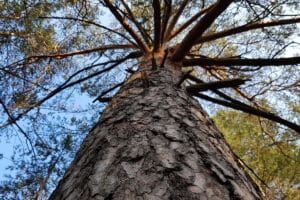In 2015, the U.S. consumed about 50 billion board feet of lumber. Softwood lumber used to build homes and made from species such as pine, fir and hemlock accounts for most of this volume. Still, U.S. markets consume billions of board feet annually of hardwood lumber. Over the past ten years, U.S. hardwood lumber consumption averaged 8.4 billion board feet, or 16.9% of total U.S. lumber use. While smaller than softwood, the sector remains plenty interesting for investors and manufacturers.
U.S. Hardwood Forests and Timberlands
The distinctive feature of the hardwood lumber sector relative to softwood sawmills is scale. While average softwood sawmill size in the U.S. continues to increase, hardwood sawmills comprise hundreds of modest-sized operations. For example, the 350 largest hardwood sawmills tracked by Forisk in the North – Lake States, Mid Atlantic and New England – average just 5 million board feet of annual productive capacity.
To feed this industry, the U.S. has growing hardwood forests and a vibrant and diverse hardwood forestland owning and investing sector. According to the U.S. Forest Service, the volume of hardwood forest inventories (growing stocks) increased nearly 130% over the past 60 years. Most of this inventory, nearly 80%, grows on privately owned forestlands, which also provides investment opportunities. For example, The Forestland Group consistently ranks as one of the three largest timberland investment managers in the United States, with 3.1 million acres under management as of February 2016. Other asset managers, such as Molpus and Forest Investment Associates (FIA) and Conservation Forestry, include hardwood forests in their client portfolios.
Hardwood Industry Trends
One of the most important exercises associated with investing in hardwood log markets for timberland investors remains confirming the existence of diverse and well-capitalized mills across the market. Who buys and uses hardwood logs in the U.S.? The top three hardwood lumber consuming sectors are pallets and crating; export markets; and railroad ties. In 2015, home-related (residential) applications – including flooring, furniture, cabinets, etc. – accounted for nearly 23% of the U.S. total.
In the Q1 2016 Forisk Research Quarterly (FRQ), Dr. Jack Lutz and I summarized how “consumer preferences” critically inform the sector (“Forecasting Hardwood Log Prices in the U.S., Part I”). On the one hand, homebuyers rarely note the species of spruce, pine, or fir studs in the walls of their houses. Builders will substitute one species for another based on price or weight or workability. In comparison, hardwood decisions involve homebuyers to a greater degree. For example:
- Flooring: strip flooring (solid wood) such as red or white oak or maple or hickory? If so, which species? In cases, price-sensitivity pushes consumers towards engineered wood/laminate flooring, or alternatives such as carpet or tile.
- Cabinets: Wood or metal? If wood, lightly stained to show the grain? Coarse or fine-grained? Or painted or darkly stained so the wood type doesn’t matter?
- Molding and millwork: “Natural” or painted wood? Consumers have shifted some to painted wood (which could be a composite such as MDF) and whitewoods, though red oak demand increased, too.
Pallets lead hardwood lumber demand for industrial users, followed by railroad ties. Truck bed floors and board road timbers comprise two other important industrial applications. In 2015, industrial markets accounted for 59% of hardwood market consumption. Pallets, railroad ties and truck bed floors all support shipping physical goods; slow-growing economies generally reduce the demand for these applications.
The U.S. enjoys a growing and diverse hardwood forest that feeds a hardwood lumber industry that lives on this diversification. The variety of facilities, the irregularity of hardwood log species and grades, and the complexity of the local supply chains create market-specific investment opportunities for those willing to put in the time. Attempts to project hardwood markets highlight a certain reality: simply owning lots of trees differs markedly from investing in high quality and valuable species.
This content may not be used or reproduced in any manner whatsoever, in part or in whole, without written permission of LANDTHINK. Use of this content without permission is a violation of federal copyright law. The articles, posts, comments, opinions and information provided by LANDTHINK are for informational and research purposes only and DOES NOT substitute or coincide with the advice of an attorney, accountant, real estate broker or any other licensed real estate professional. LANDTHINK strongly advises visitors and readers to seek their own professional guidance and advice related to buying, investing in or selling real estate.










I had two loggers at different times and neither would cut the Beech or Poplar trees. I realize they are low income wood for them but now my questions is –how do I get rid of them? I was warned that to leave them growing would cause my whole forest to be overtaken with them. So some of the saw mills buy them -standing ?